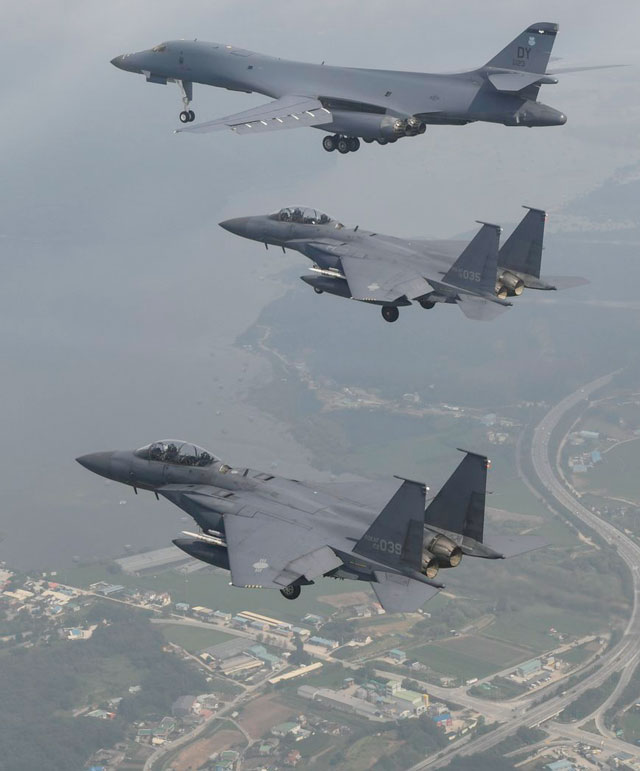
Seoul, South Korea | AFP | The US and South Korea on Monday kicked off their largest ever joint air exercise, an operation North Korea has labelled an “all-out provocation”, days after Pyongyang fired its most powerful intercontinental ballistic missile.
The five-day Vigilant Ace drill — involving 230 aircraft, including F-22 Raptor stealth jet fighters, and tens of thousands of troops — began Monday morning, Seoul’s air force said.
Pyongyang over the weekend blasted the drill, accusing US President Donald’s Trump’s administration of “begging for nuclear war”.
The annual exercise comes five days after the nuclear-armed North test-fired a new ICBM, which it says brings the whole of the continental United States within range.
As tensions surged, US Senator Lindsey Graham, an influential Republican and foreign policy hawk, warned that the US was moving closer to “preemptive war” with the North.
“If there’s an underground nuclear test (by the North), then you need to get ready for a very serious response by the United States,” Graham told the CBS show “Face the Nation”.
The isolated and impoverished North has staged six increasingly powerful atomic tests since 2006 — most recently in September.
In recent years Pyongyang has accelerated its drive to bring together nuclear and missile technology capable of threatening the US, which it accuses of hostility.
“The preemption is becoming more likely as their technology matures. Every missile test, every underground test of a nuclear weapon, means the marriage is more likely,” Graham said.
His remarks echoed those of Trump’s National Security Adviser HR McMaster, who told a security forum on Saturday that the potential for war with the North “is increasing every day”.
This year’s US and South Korean wargames feature a number of powerful jet fighters newly mobilised for the event, including six F-22s and 18 units of F-35 combat jets, the US air force said.
It also involves simulated precision attacks on the North’s military installations, including its missile launch sites and artillery units, Yonhap news agency said, citing unnamed Seoul sources.
– Risks of war –
The North has boasted that the Hwasong 15 ICBM tested on Wednesday is capable of delivering a “super-large” nuclear warhead anywhere in the US mainland.
Analysts agree that the latest test showed a big improvement in potential range, but say it was likely achieved using a dummy warhead that would have been quite light.
They say a missile carrying a much heavier nuclear warhead would struggle to travel as far.
They are also sceptical that Pyongyang has mastered the sophisticated technology required to protect such a warhead from the extreme temperatures and stresses encountered as the missile hurtles back to Earth.
The latest launch, which saw the missile drop into Japan’s economic waters, was condemned by Tokyo’s parliament Monday, which slammed the North’s rogue weapons programme as an “imminent threat”.
“This is a frontal challenge against the international community that must not be tolerated,” added the resolution by Japan’s upper house, which came as the country’s hawish Prime Minister Shinzo Abe said talking to the reclusive state was “meaningless”.
The North’s leader Kim Jong-Un has presided over significant progress in the country’s widely-condemned nuclear and missile programmes since taking power in 2011.
A nuclear standoff between Kim and Trump in recent months has seen the pair trade personal insults.
The tensions have fuelled concerns of another conflict, more than six decades after 1950-53 Korean War that left much of the peninsula in ruins.
But even some Trump advisers say US military options are limited when Pyongyang could launch an artillery barrage on the South Korean capital Seoul — only around 50 kilometres (30 miles) from the heavily-fortified border and home to 10 million people.
Estimates on the potential casualties from another war vary widely.
The North has thousands of conventional artillery units along the border with the South that analysts say could kill tens of thousands.
In one of the latest estimates, Scott Sagan, senior fellow at the Centre for International Security and Cooperation at Stanford University, said the toll could be as high as one million people from just the first day of a conflict.
 The Independent Uganda: You get the Truth we Pay the Price
The Independent Uganda: You get the Truth we Pay the Price



